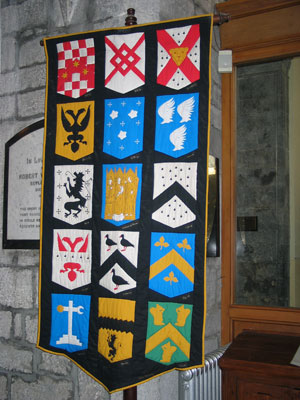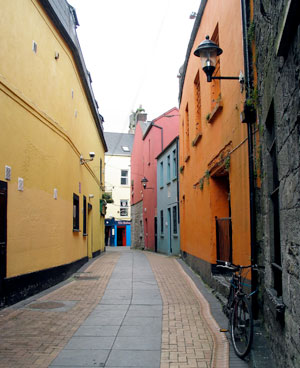GALWAY, IRELAND - An old man flashed a toothless smile and offered to help solve my dilemma - what to order from the luncheon menu at McDonagh's fish and chip shop.
"They make a lovely haddock here," said the man who later identified himself as "Tommy from Dublin."
The fish arrived a few minutes later, wrapped in a golden crust, and just as Tommy had promised, was fresh and flaky.
Hey, if Tommy knew this much about McDonagh's, then surely he would know a lot about Galway, I thought.
"So what makes Galway so special?" I asked the man who told me he came here to "learn the Gallic language," Ireland's ancient native tongue.
"Well," started Tommy, "if I told you everything that is special about Galway, we might still be here for tomorrow's breakfast."

Above: Galway Cathedral is where Columbus prayed.
Tommy then offered to prioritize the things a visitor should see while on a short stay in this 500-year-old city that was once ruled by 14 family tribes.
"Start with the new cathedral," said Tommy. "It really is a remarkable building. Lots of stained glass and marble. Off to one side, there's a room dedicated to John F. Kennedy. The former president visited Galway the year before he was assassinated and was so impressed with the efforts of the city to build a new cathedral that when he returned to America he organized a fund-raising drive. So most of the money to build the cathedral came from the States."
Later in the day, following Tommy's advice, I visited the limestone structure.
The 'new' cathedral looked like it has been part of the city's landscape since the Middle Ages. The many stained glass windows - donated by local families - are truly remarkable and the main altar is one of the most impressive in a country featuring many an impressive church altar.
"Galway was shocked when JFK was killed and named a park (in the middle of town) in his honour," said Tommy, who noted that the park is now undergoing a facelift and rumours are that it might be renamed.
"Make it a priority to visit St. Nicholas church in the old city," added Tommy.
St. Nicholas, I discovered on closer inspection, holds much of this city's history locked behind its blackened granite walls. The church that towers over the old town is where Christopher Columbus is believed to have stopped and prayed on his way to the New World in 1492. A Jane Eyre, who may have been the inspiration for the fictional character, is buried near here.
Columbus' connection to Galway started long before he sailed to America, according to Tommy. The ancient mariner apparently studied navigation in Galway back when it was an important naval centre. In fact, it was here that Columbus heard of a local monk named Brendan who had discovered a "new world beyond the horizon," in the sixth century. The rest is history

Above: Galway's streets are colourful and narrow.
St. Nicholas is an imposing structure, located off High St., the main street in the old town that features lots of historic buildings, like the remains of Lynch Castle, once owned by one of the original tribes. There are also plenty of colourful restored buildings - the most impressive of which is the Wedgwood edifice that looks just like one of the famous company's delicate creations; and lots of upscale and traditional Irish stores, like Kenny's bookshop, a literary emporium that is one of the most famous in the world and one I got lost in for several hours during my Tommy-inspired tour later in the day.
The book shop, not far from St. Nicholas, apparently gets lots of requests from Canadian university kids who want historic books on Irish culture and history, according to an attendant. The store also offers many works by Canadian authors, including Margaret Atwood, who visited the shop when she toured Galway.
You could spend most of your time in Galway examining the many fascinating things St. Nicholas has to offer.
"When you get to St. Nicholas, make sure you take note of the four-sided clock tower with the three faces," said Tommy. "When the British ruled Galway, they put a clock face on the three sides looking into the town. The fourth side, which looked outside the city where we Irish were exiled, was left blank.
"That is where the expression, 'They wouldn't give us the time of day,' is believed to have come from," said Tommy, who kept me spellbound with his fascinating facts about this beautiful city that is home to one of the country's most noted universities (National University of Ireland at Galway) and about 18,000 students. Those students, by the way, give ancient Galway a youthful feel.
Tommy also told me I would find an historic window hanging on the brick wall that surrounds St. Nicholas.
"That window is the one Governor Lynch hung his favourite son from," said Tommy.
"Goodness, what did he do with the sons he didn't like?" I wondered.
"The son killed a Spanish sailor (Galway was a seaport where the great fleets of ancient Europe docked) during a fight over a woman. Lynch, trying to prove that justice would not turn a blind eye to his son, ordered him hanged. When the governor/father/judge heard that some townsfolk were about to mount a rescue of his popular son, he hanged him from the very window that now is part of St. Nicholas's wall," said Tommy.
Tommy warned me that little of the city's original wall remains - "the piece that is still standing can be found in a downtown shopping mall," said my informative friend.
I mentioned to Tommy that I had noticed a few canals in the city centre on my way to the fish shop from my hotel base at magnificent Glenlo Abbey, built in 1740 by one of the 14 ruling families - the Ffrench - and now ruled over by the friendly Bourke clan. (The fabulous hotel is part of the Emerald Triangle group of properties - Rathsallagh House near Dunlavin and The Sand House Hotel near Donegal are the others - that give visitors a chance to see both of Ireland's great coasts and stay at three of its best properties.)
"There were many canals here in ancient times and the city was once known as the Venice of Ireland," said Tommy.
The old man ordered another tea ("because I don't drink spirits" - which prompted me to ask: "are you sure you're Irish?") and continued to offer me more tourist tips.
"When you get to the docks, you'll notice some remains of an old building and a wall," said Tommy. "That is the city's Spanish gate. Some of the sailors from the Spanish Armada are buried in the city's cemetery. Galway was never attacked by the Spanish, but many of their ships wrecked along the coastline and the bodies washed up in our river."
The same river where Atlantic salmon now come to spawn.
"You will also notice a building down on the dock - where new condos are replacing grimy old oil storage facilities - that looks totally out of place. It's a modern structure that caused quite a stir when it was built because it covered the stone ramp that Columbus used to board his ship heading for America," the old man continued.
Hours passed liked minutes as Tommy kept talking about this city where "I come to as often as I can because it helps soothe the soul."
Finally, Tommy looked at his watch, handed me a rosary, offered me a blessing in his native Gallic and suggested I have "one of McDonagh's excellent sweets" for dessert before leaving.
"I don't think I'll have time for dessert," I told Tommy. "There's just too much to see in Galway."